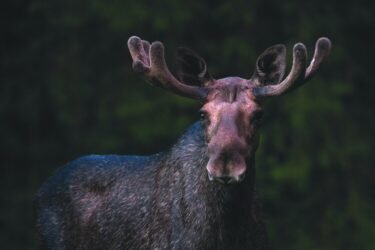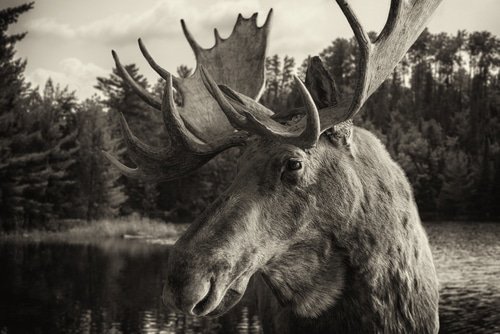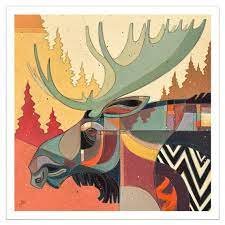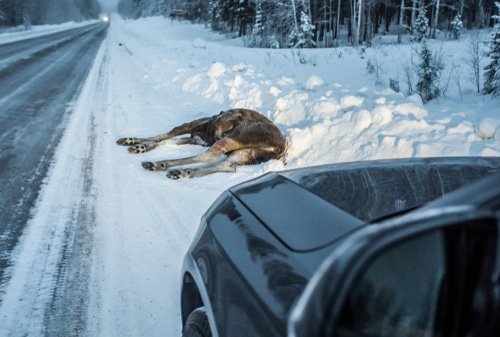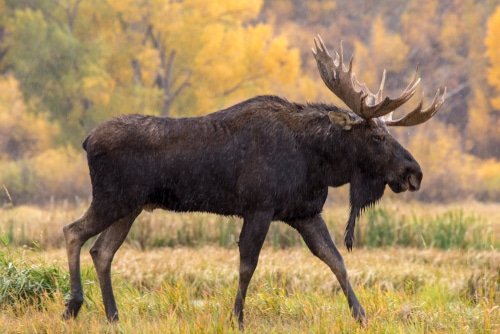When it comes to majestic creatures that roam the wild, moose undoubtedly claim a spot at the top of the list. These magnificent animals belong to the species Alces alces, which is commonly known as moose in North America and Eurasia. In this blog, we will look to discover moose in different regions throughout the country.
Brief overview of moose as a species
As one of the largest members of the deer family, moose can reach towering heights of up to 7 feet at their shoulders and weigh over 1,000 pounds. With their long legs, humped shoulders, and distinctive antlers (worn by males), these gentle giants possess an inherent aura of grace and strength.
Moose are herbivores with a voracious appetite for plants and vegetation. Their diet mainly consists of leaves, twigs, bark, aquatic plants, and even submerged vegetation in lakes and ponds.
Moose are equipped with specialized lips and teeth that enable them to browse various forms of vegetation throughout different seasons. Furthermore, moose have evolved unique adaptations suited to their habitat.
Dense fur serves as insulation during harsh winters in colder regions like Scandinavia or Russia’s Far East. Their large muzzles facilitate browsing through snow-covered ground or reaching underwater plants without difficulty.
Studying moose in different regions
The study of moose populations across different regions holds significant importance for several reasons. Firstly, understanding variations in their distribution helps us gain insights into ecological dynamics within specific habitats. For instance, analyzing Colorado moose populations reveals valuable information about their successful reintroduction efforts after decades-long absence due to human activities.
Observing variations in population densities or movement patterns can help shape conservation strategies. Secondly, studying moose habitat in Wyoming or any other region contributes valuable data on ecosystem health and biodiversity.
Moose act as indicators of environmental conditions, and changes in their populations or behavior can indicate broader ecology. Indicating moose across different regions allows us to appreciate the cultural significance these animals hold for indigenous communities.
In many parts of North America and Eurasia, moose have been an integral part of indigenous cultures for centuries, providing sustenance, materials for clothing and tools, and serving as symbols of strength and wisdom. Overall, delving into the world of moose in various regions unveils not only fascinating facts about these magnificent creatures but also provides valuable insights into ecological systems and human-animal connections.
Moose in North America
Distribution and Habitat Preferences
Regarding moose in North America, creatures can be found across various territories. From the dense forests of Alaska to the marshes of Maine, moose have adapted to various landscapes throughout the continent. However, they tend to favor areas with abundant vegetation, such as boreal forests and wetlands.
Some of the most thriving moose populations are in states like Alaska, Maine, Wyoming, and Colorado. These states provide ample food sources and suitable habitats for these majestic giants.
Subspecies of Moose Found in North America
North America is home to three distinct subspecies of moose: the Eastern moose (Alces alces americana), Western moose (Alces alces andersoni), and Shiras moose (Alces Alces shirasi). Each subspecies has its unique characteristics that set them apart from one another.
Eastern Moose
The Eastern moose is primarily found on the eastern side of North America, ranging from Newfoundland down to parts of New England. .estic creatures are known for their larger body size than other subspecies. They possess long legs and a distinctively shaped snout that helps them browse shrubs and aquatic plants in their preferred wetland habitats.
Western Moose
The Western moose inhabits regions spanning western Canada down through parts of Alaska. Compared to its Eastern counterpart, this subspecies tends to have smaller body sizes but compensates with more massive antlers. The Western moose thrives in areas with diverse vegetation, like mixed coniferous forests and meadows near water sources.
Shiras Moose
The Shiras moose, also known as the Wyoming moose, calls the Rocky Mountain region its home. Specifically found in states such as Wyoming, Colorado, and Utah, these moose have adapted to the unique mountainous terrain found in these areas. They often favor dense forests and can be spotted grazing on willows and other shrubs that grow along streams or meadows.
Unique Characteristics and Adaptations of North American Moose
North American moose possess several remarkable features that help them thrive in their habitats. One of their adaptations is their impressive antlers, primarily used for attracting during the breeding season but also serve as valuable weapons for defense against predators.
Additionally, these ungulates have long legs that allow them to navigate through deep snow during harsh winters. Their large muzzles are perfectly designed for browsing vegetation in water and on vegetation. Finely tuned over time, North American moose have become a symbol of natural resilience and grace amidst the rugged landscapes they call home. Overall, North America offers a diverse range of habitats for its magnificent moose populations.
From the towering forests of Alaska to the scenic Rocky Mountains, each subspecies has carved out its niche within this vast continentderstanding their distribution patterns and distinctive characteristics allows us to appreciate the beauty and adaptability of these awe-inspiring creatures who roam freely throughout our wildernesses.
Eurasian Moose
The Eurasian moose, scientifically known as Alces alces, is a majestic and fascinating creature that roams across the vast expanses of Europe and Asia. This magnificent species also referred to as the elk in Europe, holds a significant place in the ecological systems of these regions. The range and distribution of Eurasian moose is extensive, covering diverse habitats from Scandinavia to the Russian Far East.
Range and Distribution across Europe and Asia
The Eurasian moose has an extensive range that stretches across various countries in Europe and Asia. In Europe, they can be found in countries such as Sweden, Finland, Norway, Poland, Latvia, and Estonia.
Moving eastward into Asia, they populate regions including Russia (Siberia), Kazakhstan, Mongolia, China (Heilongjiang province), and even parts of Japan. Their ability to adapt to different climates is remarkable – from the frosty Scandinavian forests to the hot summers of Mongolia.
Subspecies Diversity within Eurasian Populations
Within the Eurasian moose species lie different subspecies that display distinct characteristics adapted to their respective habitats. Let us explore some of these fascinating subspecies:
1) Scandinavian Moose (Alces alces alces): Found primarily in Scandinavia (Sweden, Norway), this subspecies is renowned for its larger body size compared to other European populations. With their long legs designed for traversing through dense forests and wetlands with ease,
Scandinavian moose have become an iconic symbol of wildlife in this region. 2) Siberian or Yakutsk Moose (Alces alces pfizenmayeri): Inhabiting the vast wildernesses of Siberia and parts of Kazakhstan and Mongolia,
the Siberian moose stands out for its adaptability to extremely cold climates. These moose have evolved with thick, shaggy coats and strong muscles to endure the harsh winters of northeastern Asia.
3) Kamchatka or Kolyma Moose (Alces alces burkini): Named after their regions, these moose populations can be found in the Kamchatka Peninsula and Kolyma River basin in Russia’s Far East. Kamchatka and Kolyma moose are known for their impressive antler size, as they reside in areas abundant with nutritious food sources that allow them to reach their full genetic potential.
Comparison between North American and Eurasian Moose Populations
While North American and Eurasian oolong are the same species, there are notable differences between the populations inhabiting these continents. One significant distinction lies in body size – generally, Eurasian moose tend to be larger than their North American counterparts.
Additionally, variations exist in antler morphology and behavior patterns due to different environmental pressures and the availability of resources. The breeding habits of Eurasian moose also differ from those of North American moose due to variations in vegetation types across their respective habitats.
Understanding these distinctions helps researchers gain insights into how diverse environments shape the evolution and characteristics of this magnificent species. Whether observing the majestic Scandinamoose navigating through boreal forests or marveling at the adaptability of Siberian or Kamchatka moose surviving extreme climates, each unique subspecies contributes an invaluable piece to our understanding of nature’s wonders across Europe and Asia.
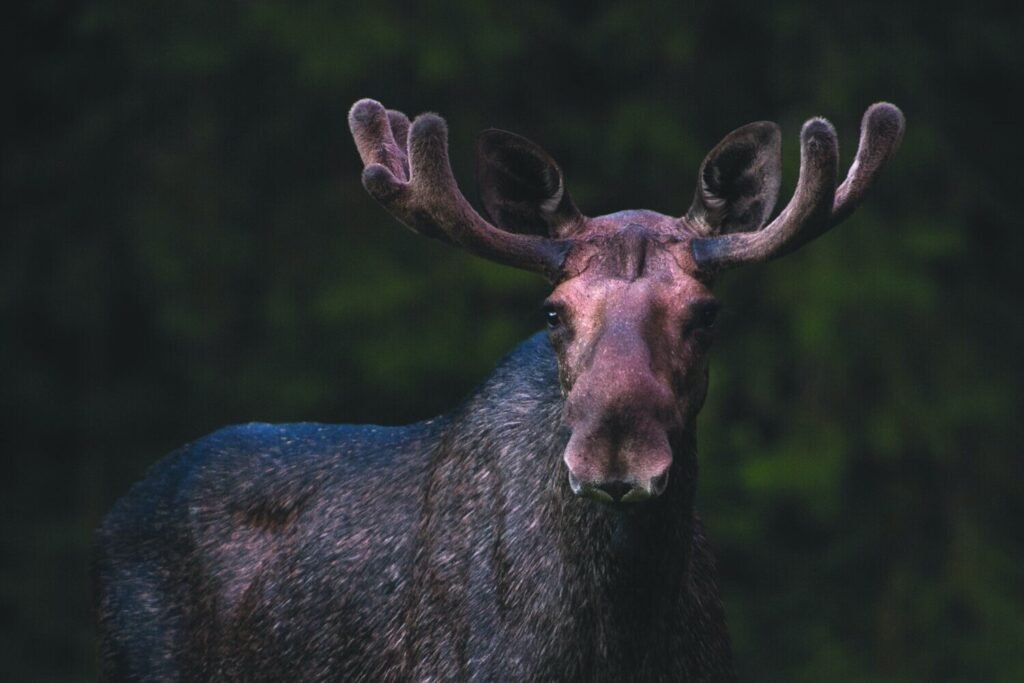
Moose in Scandinavia
Historical Significance of the Scandinavian Population
The moose population in Scandinavia holds immense historical significance. These majestic creatures have been a part of Scandinavian culture and folklore for centuries, captivating the imaginations of locals and visitors alike.
Revered as the “King of the Forest,” moose have played a central role in ancient tales and legends, symbolizing strength, resilience, and the spirit of nature. Whether through traditional stories passed from generation to generation or intricate wood carvings adorning ancient churches, the presence of moose in Scandinavian history is undeniable.
Habitat Preferences and Behavior Patterns Unique to Scandinavian Moose
Scandinavian moose have developed habitat preferences and behavior patterns that are distinctively their own. These gentle giants find solace amidst the breathtaking boreal forests and tranquil wetlands throughout Sweden, Norway, Finland, and Denmark.
With their elongated legs perfectly adapted for traversing this rugged terrain, they gracefully move through dense thickets and navigate marshy areas with ease. The bond between Scandinavian moose populations and their habitat is unbreakable – they rely on these unique ecosystems not just for sustenance but also as a refuge from predators.
Relationship with Boreal Forests and Wetlands
Scandinavian moose flourish within boreal forests that blanket vast expanses of their range. These forests offer abundant food sources such as young shoots, leaves, bark, twigs, and aquatic plants found near wetland areas where they often graze contentedly. Their presence helps maintain the delicate balance within these ecosystems by shaping vegetation growth patterns through browsing habits.
Seasonal Migrations
In tune with nature’s rhythm, Scandinavian moose engage in seasonal migrations that are crucial for their survival. As winter approaches with its biting cold and scarce food availability, moose gather in designated areas where they can find sufficient forage and shelter. These migrations are not only driven by the search for better resources but also serve as a means of avoiding harsh winter conditions and reducing predation risks.
Feeding Habits
Scandinavian moose are herbivores with a diverse palate. They feed on various vegetation, including various aspen and even aquatic plants, during the warmer months.
During winter, when food sources become limited due to snow cover, they browse coniferous trees such as pine and rice. Their large size allows them to consume substantial quantities of plant matter daily to sustain their energy levels.
Conservation Efforts to Protect Scandinavian Moose
Recognizing the importance of preserving this iconic species and its habitat, extensive conservation efforts have been implemented throughout Scandinavia. Governments work closely with environmental organizations to enforce hunting regulations and ensure sustainable management practices. Initiatives focus on protecting critical habitats through land preservation measures while promoting public awareness and responsible wildlife interaction.
By balancing human activities with the needs of Scandinavian moose populations, these conservation efforts strive to safeguard their long-term survival for generations to come. Scandinavian moose hold both historical significance and possess unique habitat preferences that make them distinct from other moose populations around the world.
Their bond with boreal forests and wetlands is profound, guiding their seasonal migrations and influencing their feeding habits. Through dedicated conservation efforts in Scandinavia, these magnificent creatures continue to thrive amidst breathtaking landscapes that have shaped their existence for centuries.
Moose in Russia’s Far East
An Enchanting Wilderness
The vast and captivating Far East region of Russia is home to a diverse array of wildlife, including the majestic moose. Stretching across Siberia and the Russian Pacific Coast, this enchanting wilderness provides a unique habitat for moose populations. The region’s pristine forests, wetlands, and mountainous landscapes offer ideal conditions for these magnificent creatures to thrive.
Distribution, Habitat, and Behavior Patterns
Moose in Russia’s Far East showcase their adaptability to various regional ecosystems. The regional ecosystems rest of Eastern Siberia to the coastal plains of Primorsky Krai. These populations have evolved distinct characteristics influenced by their specific habitats.
In Eastern Siberia, where expansive boreal forests dominate the landscape, moose have adapted to withstand harsh winters marked by deep snow cover. Their long legs let them traverse snowy terrain with a relative forage on willow and birch trees.
On the coastal plains of Primorsky Krai near Vladivostok, moose inhabit dense taiga forests along with deciduous broadleaf trees such as oak and ash. This unique habitat provides abundant food sources during summer months when they indulge in browsing on leaves and aquatic vegetation.
Behaviorally, moose in Russia’s Far East exhibit seasonal migrations influenced by food availability and breeding patterns. They move between lower elevation river valleys during winter months when food becomes scarce to higher mountain ranges during summers when meadows filled with succulent grasses await them.
Conserving a Natural Wonder
Efforts are underway in Russia to conserve these remarkable animals and protect their habitats. National parks such as Sikhote-Alin Nature Reserve provide sanctuary for these moose populations while ensuring sustainable tourism that educates visitors about wildlife conservation. By safeguarding the Far East’s ecosystems and implementing measures to mitigate human-wildlife conflicts, the hope is that future generations will continue to marvel at the beauty of these magnificent creatures in their natural environment.
Conclusion
Exploring the regions where moose roam, we uncover a tapestry of diversity and adaptation. From the sprawling forests of North America to Russia’s Far East, each population has unique traits shaped by its specific habitats. While challenges such as habitat loss and climate change persist, conservation efforts across these regions bring hope for a brighter future.
By safeguarding moose populations and preserving their habitats, we ensure that these iconic creatures continue to inspire awe and wonder for generations to come. So, let us embrace this journey of understanding and protection, cherishing every encounter with these gentle giants as an opportunity to appreciate the resilience of nature’s remarkable creations.

